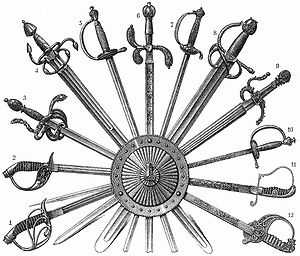Asi (Mahabharata)
The common term for "sword" in Classical Sanskrit is khaḍga (whence modern Hindi khanda), in Rigvedic Sanskrit still as a term for a kind of sacrificial dagger or knife.
This word appears as a proper name, Asi, of the personification of the first sword created by Brahma. A legend concerning the sword appears in the Shantiparva section of Mahabharata (MBH 12.167.1-87 Vulgo; MBH 12.161.1-87 (Critical)) .[1]
Frame narrative
Out of curiosity, Nakula, the fourth son of Pandu and the master of swordsmanship, had questioned the Kuru Grandsire Bhishma, on his arrowy death bed, as to which was the best weapon in all kinds of fighting. In his own personal views, Nakula thought the sword to be the most superior, since even on having lost one's bow, horse and the chariot, a skilful swordsman could still defend himself against the mace and spear wielders. Nakula further queried the Grandsire about the origin and purpose of the Khadga as well as about its first acharya ("teacher, preceptor").
Gladdened by these intelligent queries by Nakula, Bhishma related to him the complete Itihaasa (Sanskrit term for 'History') of the Khadga or "divine sword" starting from its creation down to the present (i.e., time of Bharata war).
Creation of asi
The Gods, or rather Devas, approached Brahma, the creator of the universe, and protested against the unjust rule and evil doings of the demons (Danavas, namely Asuras, who belonged to an evil human race with giant build). Hearing the protest from the Gods, Brahma collected sacrificial objects and proceeded to perform a grand sacrifice with the foremost of the Rishis and Devas at the side of Himalaya.
During the course of the sacrifice, a dreadful creature sprang from the midst of the sacrificial fires scattering flames all around. It was as though a moon had arisen in the midst of the stars. He was colored like a deep-blue lotus. His teeth were sharp and terrible, stomach lean and skinny and stature very tall and slim. He was of exceeding energy and power. Simultaneously, the earth started shaking, there were turmoils in the oceans, the forceful winds started howling all around, the trees started falling and being torn apart, and the meteors started blazing through the skies!
Brahma declared:
- The 'being' I have conceived is Asi. It shall effect the destruction of the enemies of the gods and restore the Dharma (righteousness).
Upon this, the creature assumed the form of a blazing, sharp-edged sword, glowing like the flames at the end of the Kalpa (aeon).
Succession of wielders of asi
Brahma gave that sword to Rudra with the bull-banner and asked him to put down the sinners and evil-doers and restore the Dharma.
Rudra, assuming his terrible form, took up the sword and started the war against the Danavas, thus tearing, piercing, lopping off, chopping off and smashing and mutilating these enemies of the Devas and the Praja.
The earth became miry with flesh and blood of Daityas (or giants) and looked like a fair-complexioned maid intoxicated with alcohol and attired in crimson robes in a full abandon.
Having extirpated the entire community of Daityas and after restoring Dharma, Rudra cast off his awful form and assumed the usual benign shape Shiva.
Rudra gave the sword, dyed with the blood of the Daityas, to Vishnu. He gave it to the Indra. Deva Indra, then gave it to other Devas.
The Devas then presented the mighty sword to Manu, advising him to wield it with utmost care, only resorting to it for punishing the transgressors of the Dharma. Mutilations and death punishments shall never be inflicted for small transgressions.
Manu used this Daevi Khadga or Divine Sword wisely and then passed it to his son Kshupa. From Kshupa it passed to Manu's other son Ikshvaku. From him it went to Pururavas, born of Ila. From him it went to Ayu. From him it passed to Nahusha. From him it passed to Yayati. From him it passed to Puru. From him it was wrested by Amurtarayas of the clan of the Amavasus. From him it went to Bhumishaya. From him it went to Bharata Daushyanti. From him it went to Ailavila, the upholder of Dharma. From him it went to Kuvalashva, the Aikshvakava of Kosala.
From king Kuvalashva, the sword was wrested by Kamboja i.e. the king of Kambojas.
From Kamboja, the Khadga passed on to Muchukunda (of Ikshvaku dynasty). From Muchukunda it went to Maruta.
From Maruta it went to Raivata. From him to Yuvanashva. From him it went to Raghu, the great conqueror. From him it went to Harinashva. From him it went to Shunaka. From him it went to Ushinara. From him it went to the Bhojas and Yadavas. From the Yadus it went to Shivi. From him it went to the Partardanas of Kashi. Then it was taken by Vishvamitras of the Ashtaka lineage. Then it was taken by the Panchala Prishadashva. From him it went to the Brahmins of the Bharadvaja lineage. The last of that lineage was Drona. He gave to Kripacharya. He in turn gave it to the Pandavas.
Krittika is the Nakshatra of the sword, Rohini the gotra, Agni the deity, and Rudra the Maharshi. It is truly the upholder of Dharma.
It is the foremost of the striking weapons of the son of Madravati.
References
- ↑ Political and Moral Concepts in the Śāntiparvan of the Mahābhārata, 1990, p 166, Y. S. Walimbe.
External links
- Mahabharata Sword
- The Mahabharata: Book 11: The Book of Peace, Part 1, edited by James L Fitzgerald
- Durga Puja, pp lviii-lix, Pratāpacandra Ghosha
| |||||||||||||||||||||
| |||||||||||||||||||||||||||||||||

